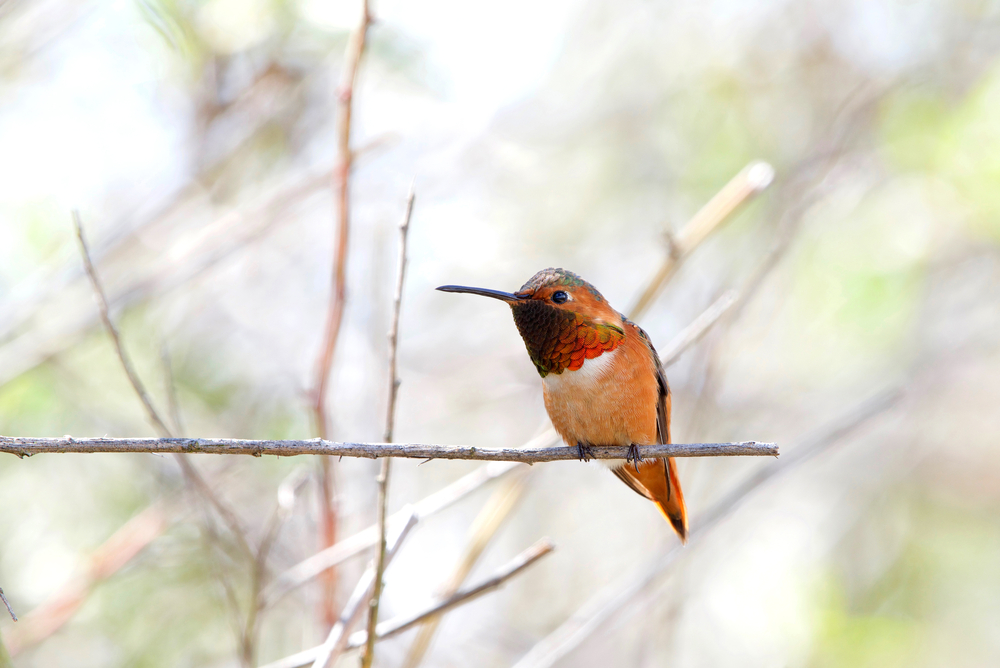Hummingbirds are a group of birds found throughout North and South America. They are known for their high-pitched “buzzing” sound and their ability to hover in mid-air. There are over three hundred species of hummingbirds.
The smallest hummingbird is the Cuban Bee Hummingbird, which measures just 2 inches in length. The largest is the Giant Hummingbird, which can reach 8 inches.
These birds have bright colors and a distinctive “bobbing” flight pattern.
Hummingbirds feed on nectar, and they are essential pollinators of many plant species. They also eat insects, which they catch in mid-air.
Most hummingbirds live in the tropical and subtropical regions of South America, but several species live in North America. The Ruby-throated Hummingbird is the only species breeding east of the Mississippi River.
These beautiful birds are often flitting about in gardens and parks across the United States. They can hover in mid-air while they drink nectar from flowers and fly upside down. The hummingbird is the only bird that can fly backward.
Hummingbirds are migratory birds, and they typically migrate southward in the fall. Hummingbirds do not migrate in flocks like many other birds.
If you see a hummingbird, it will be an exciting experience. These tiny birds are full of life and energy, and they are a joy to watch.
Wisconsin Hummingbirds
Wisconsin is home to several species of hummingbirds. The ruby-throated hummingbird is the most common, but Broad-Billed, Anna’s, Violetear, Allen’s, and Rufous hummingbirds fly here as well.
All hummingbirds are in the order Apodiformes and the family Trochilidae. They are tiny birds, with most species measuring three-to-five inches in length.
Hummingbirds are brightly colored, with iridescent feathers. The males often have brighter colors than the females.
Birds that breed in the northern part of their range will typically migrate south for the winter, while those in the southern region will remain in their breeding grounds year-round.
You can attract hummingbirds to your yard by planting flowers rich in nectar. Good choices include bee balm, bleeding heart, columbine, and impatiens. These birds do not have a sense of smell, but they seek out orange and red flowers.
You can display a hummingbird feeder filled with sugar water. Be sure to clean the feeder regularly to prevent the growth of harmful bacteria. Red dye is toxic to birds, so attract them with colorful flowers instead.
Hummingbirds are also known for their fast flight speeds – they can fly up to 50 miles per hour.
If you want to see hummingbirds, your best bet is to visit a nature center or park during the summer months. You may be able to see them at roadside wildflower areas in the spring and fall.
Look for these birds flitting among the flowers, their wings a blur as they hover in mid-air.
Here are some more fun facts about hummingbirds:
- The average lifespan of a hummingbird is five years.
- Most hummingbirds live in the tropical and subtropical regions of South America, but several species live in North America.
- A hummingbird’s heart beats over one thousand times per minute.
- Hummingbirds are brightly colored, with iridescent feathers. The males usually have brighter colors than the females.
- Hummingbirds are the second biggest family of birds.
- Hummingbirds are known for their fast flight speeds – they can fly up to 50 miles per hour.
- If you want to view hummingbirds up close, your best bet is to visit a nature center or park during the summer months. You may also see them at roadside wildflower areas in the spring and fall.
- Hummingbirds consume nectar by moving their tongue thirteen times per second.
- Hummingbird eggs are about the same size as a coffee bean.
- Hummingbirds cannot walk or hop.
- Hummingbird tongues are shaped like a W.
- Hummingbirds breathe one hundred fifty times per minute.
- Hummingbirds see in ultraviolet light.
Here are the six hummingbirds that are seen most frequently in Wisconsin:
Anna’s Hummingbird (Calypte anna)
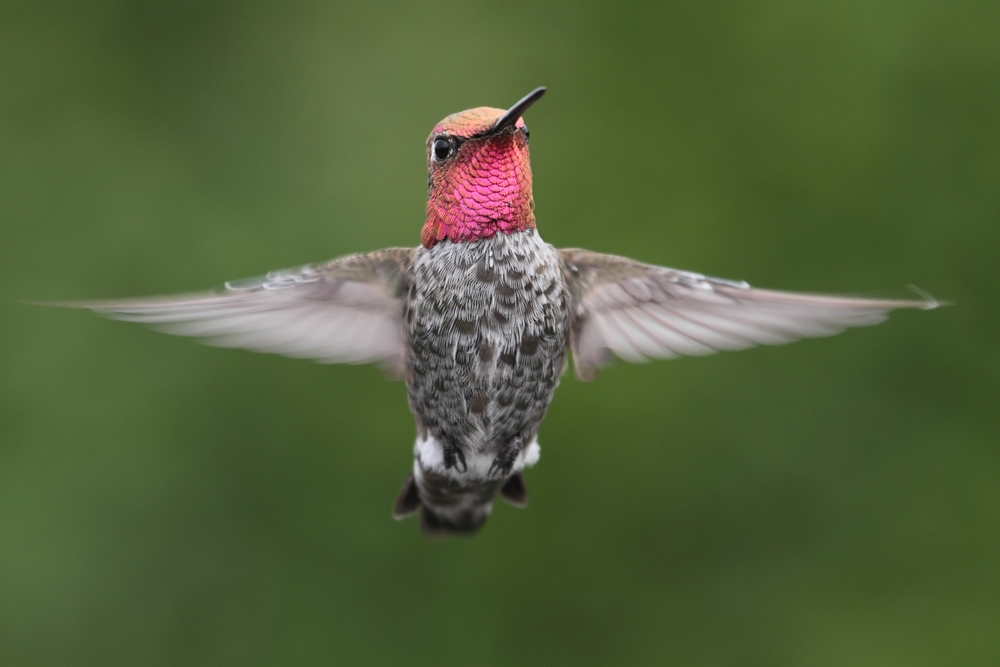
Anna’s hummingbird is a tiny, iridescent hummingbird occasionally found in Wisconsin. Their green and gray feathers can identify them. Males have a dark pink throat.
Anna’s Hummingbirds feed mainly on nectar from flowers, but they will also eat insects. You can find Anna’s Hummingbirds throughout the state during the summer months.
During the breeding season, males will display their colorful tail feathers to attract mates.
Anna’s are one of the largest hummingbirds in the United States, and they are very vocal. They are territorial and are known to dive-bomb other birds and humans.
Ruby-throated Hummingbird (Archilochus colubris)
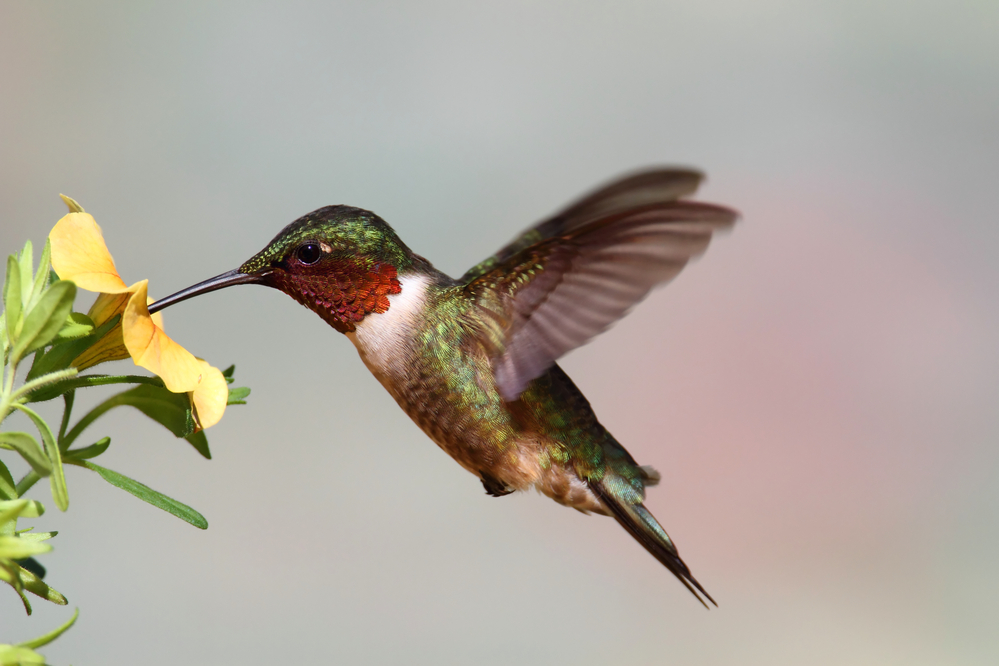
Ruby-throated hummingbirds nest in many parts of the state, but they are more common in the southern and eastern regions. These hummingbirds migrate to Mexico for the winter, but a few may stay in Wisconsin if the weather is mild.
Ruby-throated hummingbirds are the only hummingbird that nests in Wisconsin. They are migratory and stay in the eastern half of the United States.
Ruby-throated Hummingbirds feed mainly on nectar, but they will also eat insects. Insects are an essential source of protein for these birds, particularly during the breeding season when they need to produce eggs.
You can find these hummingbirds in Wisconsin from late April through early October. A few may remain as late as December.
This hummingbird does well in Wisconsin because it has adapted to living and eating in people’s yards. They will often build their nests near houses and in gardens.
The ruby-throated hummingbird resides in the eastern United States and southeastern Canada, and it spends the winters in Central America. It migrates through Wisconsin in the spring and fall.
The ruby-throated hummingbird is emerald/gold green, with a white and gray breast. Males have an iridescent red throat.
Broad-Billed Hummingbird (Cynanthus Latirostris)
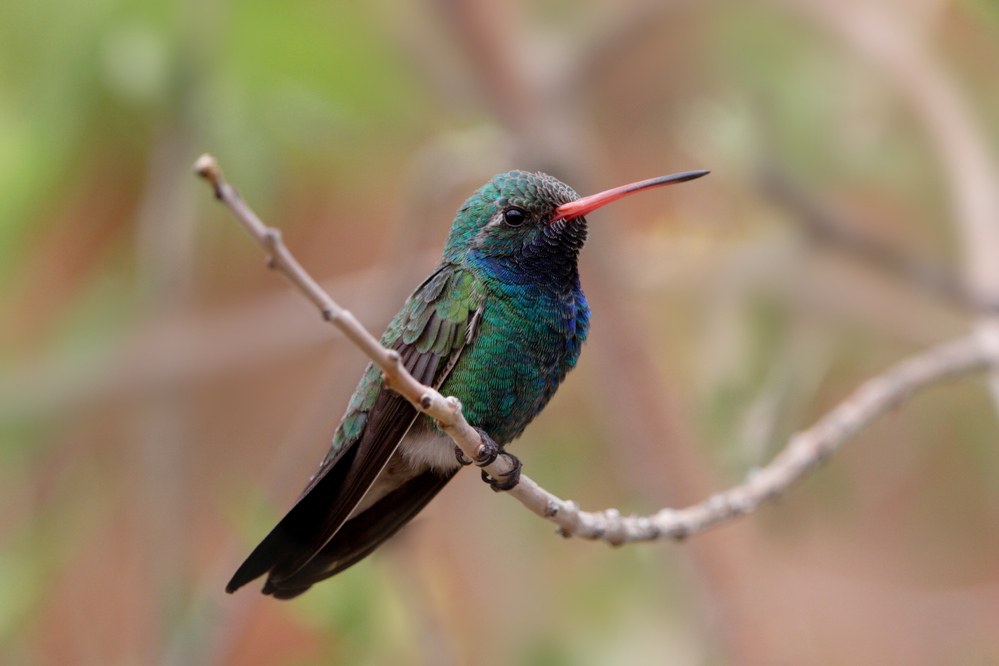
The Broad-billed Hummingbird is a species that breeds in the southwestern United States and Mexico. It is a rare visitor to Wisconsin, with only a handful of records.
The male can be identified by its green back, broad, red bill, and blue throat, while the female’s throat is gray.
Broad-billed hummingbirds construct small nests from vegetation and spider webs. They lay two-to-three white eggs per clutch.
These hummingbirds feed mainly on nectar, but they will also eat insects. You can find them in Wisconsin from late April through early October.
Green Violetear Hummingbird (Colibri thalassinus)

The Green Violetear hummingbird is a species that breeds in forest clearings in Mexico and Central America. It is only occasionally seen in Wisconsin.
You can identify this bird by its green back and violet-blue ear patch. The male has a white throat, while the female’s throat is light buff.
This hummingbird has a quick, erratic flight pattern and a high-pitched “buzzing” sound it makes as it hovers in mid-air.
Its range extends from southern Canada to northern Mexico.
If you’re lucky enough to spot a Green-Violet Ear Hummingbird in Wisconsin, you’ll receive a beautiful sight and the unique sound of this fantastic bird.
Rufous Hummingbird (Selasphorus rufus)
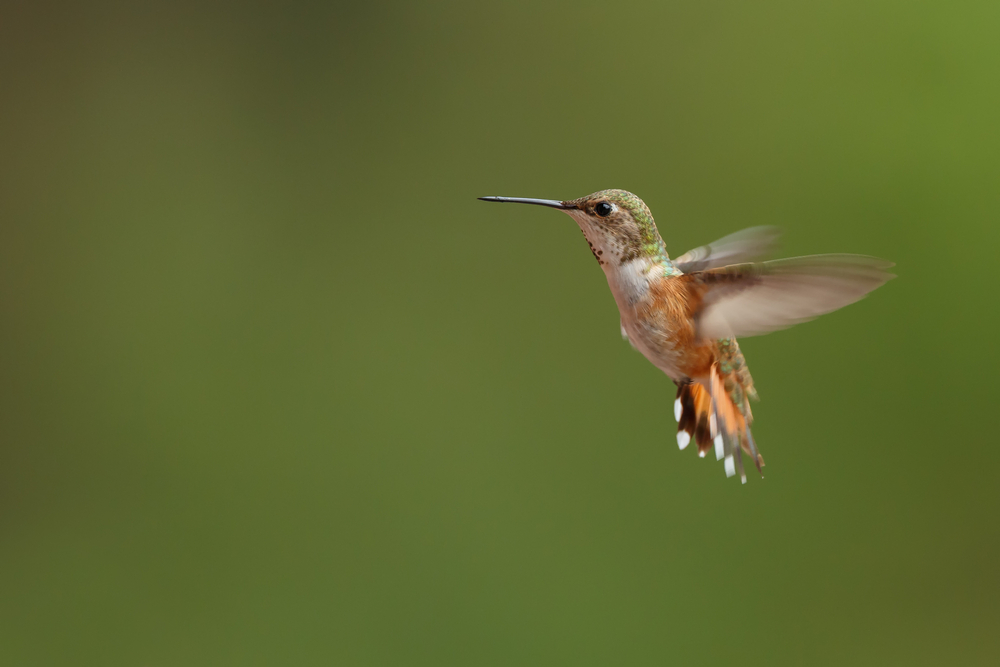
The Rufous hummingbird is the second most common hummingbird seen in Wisconsin after the Ruby-throated, but sightings are still rare.
Rufous are relatively small, just three inches long and have reddish-brown feathers on their back and tail. The males also have a bit of green on their heads. Females generally have duller plumage than males.
Rufous Hummingbirds live in various habitats, from forests to gardens and urban areas. They eat different things, including nectar, insects, and spiders.
These birds show up across the state. They migrate south for the winter, but some may stay in Wisconsin year-round.
Rufous hummingbirds are territorial and may scare away other species attempting to feed.
Allen’s Hummingbird (Selasphorus sasin)
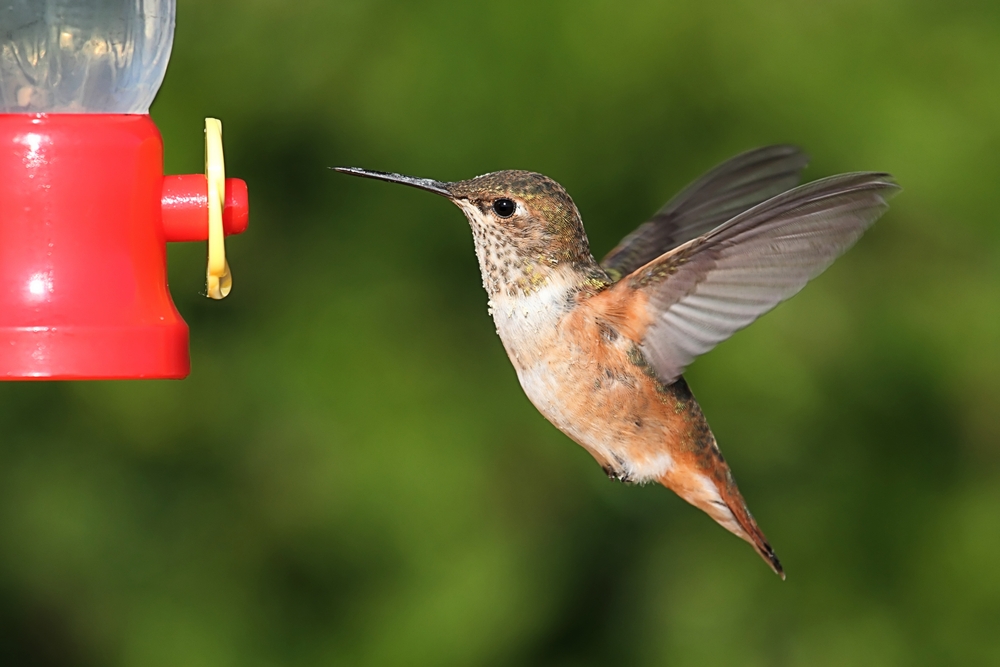
The Allen’s hummingbird is typically three inches long and has a green back and a red throat. You can identify them by their thin black bill and their lack of a tail streamer.
Allen’s hummingbirds migrate very early. Birds wintering in the south will head north as early as January to access the first blooming flowers. Allen’s are often confused with Rufous hummingbirds due to their similar appearance.
They nest in woods and gardens near the coast of California.
Conclusion
Hummingbirds are some of the most interesting birds in North America. They’re small, can fly backward, and have a beautiful appearance.
There are over three hundred species of hummingbirds globally, around twenty different species that can live in the United States, and six or so that make appearances in Wisconsin.
While you’re unlikely to see most species of hummingbird in Wisconsin, there are still a few that hang around and provide us with a glimpse.
Hummingbirds are an important part of the ecosystem, as they help pollinate flowers and control insect populations. They are a beautiful sight and are worth a trip to observe in the wild, so keep your eyes open and your feeder full.
